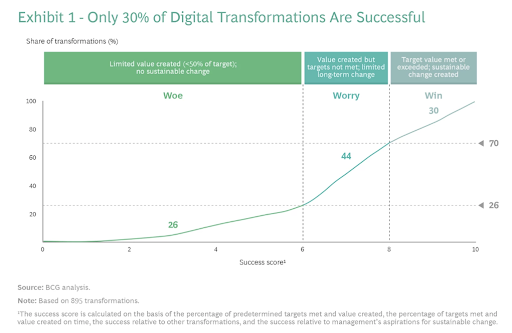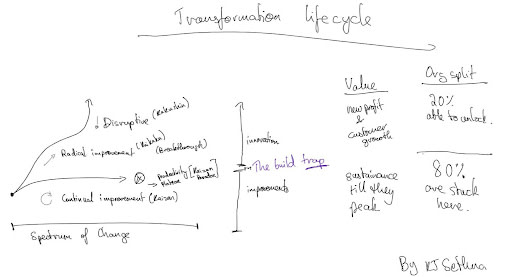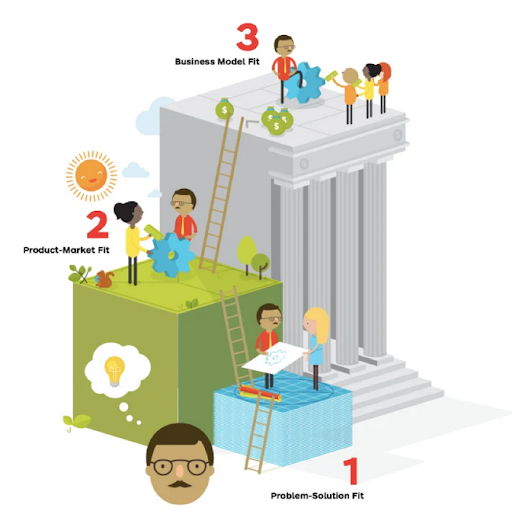18 Sep 2023
A Series of Guides on Avoiding Enterprise Digital Transformation Failure - Part 1
Product StrategyAgile / Digital transformation is a multi-billion-dollar industry with feature factories and strong cargo cults, also known as the Agile Industrial Complex or Agile Cargo Cult.
In this series, we will look at how to enable innovation while avoiding the failures of the Agile Industrial Complex (AIC).
Agile’s enterprise documented failure
In 2020, BCG did a study across 900 transformations and showed that 70% of them failed. We could argue that the AIC, lives off failed Agile / digital transformations.

The purpose of this guide
There is plenty of content out there on how to avoid failed digital transformations, however, most of it is just for SEO or lead generation purposes.
If the content would address the AIC, it would be counterintuitive to the profit stream that it generates and risk the livelihoods of the millions of folks in this industry, so this is generally avoided.
This series aims to help execute a digital transformation without the BS that the AIC brings while raising awareness on what really matters.
In Part 1 we look at
What should "Enterprise Digital Transformation" be?
Which enterprises need to transform?
3 things to watch out for in enterprises while transforming.
Product management’s role in digitally transforming an enterprise.
What should Enterprise Digital Transformation be?
Continuous value delivery across both business and customer
A continuous journey of reimagination of an enterprise in a world where digital technology increases the value of the organization, its products, operations, and services. This is a journey where the evolution of strategy, culture, people, process, and technology takes place over an indefinite period of time. Continuous transformation becomes the culture and strategy. It enables Innovation.

Customer centricity is not just a lip service
A world where the voice of the customer is not just lip service.
Transformation is not something where you start and stop, it is a continuous journey, ever-evolving.
Due to the Agile Industrial Complex, most organizations see transformation as a “project”, and this is where they end up in the kaizen paradox.
When we look at a business’s lifecycle, the most important is the plateau point which is the Kaizen Paradox concept, if a business gets stuck here it kills innovation and the transformation journey fails. I wrote the concepts of Kaizen, Kaikaku, and Kakushin in the article The Kaizen Paradox.

Which enterprises need to transform?
Any enterprise that is looking to “reignite” its spark should look at transformation as a continuous journey, not a “transformation program”.
There are 4 ideal triggers that can lead to the realization of a transformation journey:
Value proposition redesign
An organization with products and services has lost its value proposition. i.e.: a situation where innovation & growth has stunted. e.g.: A car manufacturer that is struggling to grow market share and keep up with times because its product and services do not have any unique advantages for the customer base and the technology being used has become outdated.
Digitization of the customer journey
An organization that has products and services in a traditional delivery format and wants to keep up with new technology implementations and upgrade its experience. e.g.: A car manufacturer that wants to digitize its customer’s purchase journey from “building your car online”, “getting a quote”, “booking a test drive” and “contract of sale”.
Digitization of enterprise operations for efficiency
An organization that wants to change the people, processes, and technology it uses to improve efficiency, reduce the cost base, and improve operational effectiveness and efficiency. e.g.: A car manufacturer that needs to reduce operational expenses in order to improve commercial margins through optimization of its people, processes & technology. For instance, reduce the cost base of having multiple physical showrooms and have a delivery center that is optimized to provide an e-commerce-like purchase experience for a car buyer. A typical example here is generally the type of organization that goes from pureplay sales-led growth to product-led growth.

Change of enterprise business models
An organization that wants to change its business model or playbooks while changing its target market audience and ideal customer profile. e.g.: A car manufacturer that goes from Business to Business to Consumer (B2B2C) to (D2C) Direct to Consumer model, changing the way the entire business functions and the experience the customer gets. Think of this as all of the above in one set.
3 things to watch out for in enterprises while transforming
1. Lack of alignment and direction on why the organization is transforming.
This is the most common problem in any transformation journey. It generally manifests itself in 3 different ways.
Lack of alignment on transformation goals
How to avoid this? – Conduct goal discovery, this helps drive alignment and direction as it helps focus on an expected outcome. I wrote about the three types of goals discovery that are critical here. When the goals are unclear the transformation journey reaches a ceiling and stunts.
No shared direction on vision
While vision may seem like fluff as I wrote about its critical importance and how to bring about clarity in this guide here, it impacts value creation and is a critical piece of influencing and driving decisions.
Lack of buy-in from leadership on transformation
More often than not, lack of alignment on transformation starts at the top. Part of the issue here is digital maturity that I shared in this guide here. Not having buy-in impacts adoption and critical decision-making.
2. Lack of change management & resistance from the old guard
Every organization will have “protectors” of ways of working who will be resistant to change and try to derail any transformation effort. Why? The chaos that arises from resistance, increases the stickiness and reliability of the old guard. I have seen this manifest itself in the following ways
No change management strategy
Transformation and change management aren’t the same thing. Transformation requires change management.
Change management is a core competency like product management. Many organizations will not invest in this because of their lack of awareness of the need for this competency in an organization. Change management also may be dumped on a contractor or project manager to execute and these folks generally either lack the experience or do not know what goes into change management.
Internal resistance to change
A psychology study on resistance to change showed that the success of change execution efforts largely depends on shaping employee attitudes toward change.
Primeast a leadership development and training organization shared 7 strategies for overcoming resistance in this article here. TLDR; watch their 4-minute YouTube video here.
Going through a transformation too fast and poor adoption of new technologies
Along my transformation journeys, I have found this one out the hard way. Bringing people along with you is key to getting a successful change in behaviors and impacts adoption and engagement. McKinsey has an article on the ideal speed of a transformation here. They talk about embedding capability building in the transformation journey and its importance.
3. Strategy on delivering value first then focus on parity with the competition
Reacting to competitors instead of investigating your actual digitalization needs is a critical problem in the transformation journey. This hinders investigation and research into the understanding of customer expectations and needs.
In an ideal transformation journey, the transformation efforts go into looking into what the Ideal Customer Profile is and then building value in that segment and targeting them.
I.e.: Focus on problem discovery with a view of opportunities to solve and experiments to run. Leah Tharin writes about the cost of scaling the non-ideal customer profiles here.
Product management’s role in digitally transforming an enterprise
This is where the role of product discovery comes in. Don't just set OKRs/ goals every quarter or year & then go " build " stuff in an Agile manner with a roadmap. That is a recipe for a feature factory.
In 2023, product management helps connect the dots from “strategy to the tactical” through continuous discovery.
The most important role in any business transformation journey is the role of the product management team.
Why?
Product management has introduced critical practices into the transformation journey that changed the outcomes of any transformation.
For instance, product management helps look at behavioral psychology, behavioral economics, growth marketing, and user-centered design which optimize the value creation for a product stream.
Product management also then goes into deeper discovery across the problem and solution space to create or optimize value by innovating on a product’s value propositions. Product lifecycle involves building out a product to meet a problem solution fit, which is then followed by product market fit and then by business model fit.

Product managers should ensure that the businesses they work for stay competitive and innovative during this lifecycle.
They can do this by ensuring the products they are working on stay:
Valuable
Viable
Feasible
Desirable
Stay tuned for Part 2/3 of the series where I will go into core areas of enterprise digital transformation.

KJ Sethna

Read also
Create effective product strategy




